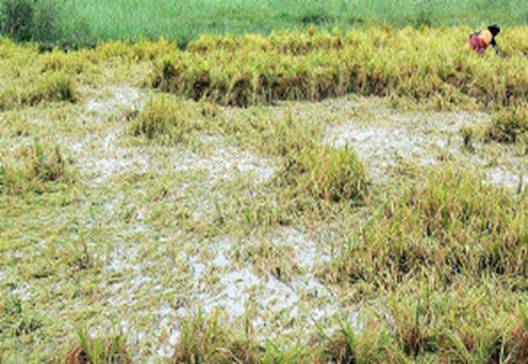
|
|||||||||||||||||||
| Home | Seasons & Varieties | Tillage | Nutrient Mgmnt | Irrigation Mgmnt | Weed Mgmnt | Crop Protection | Cost of Cultivation | Photobank | |||||||||||||||||||
Stress Management :: Flood |
|||||||||||||||||||
About Flooding (High moisture stress)
Water logging refers to a condition when water is present in excess amount than its optimum requirement. It creates an anaerobic situation in the rhizosphere due to which the plant experiences the stress (O2 deficient stress). Nature of Water logging Stress In the water logged soils, water gets filled in the pores of the soil which are previously occupied by O2. Such soils suffer O2 deficiency. This O2 deficiency depresses growth and survival of plants growing in it. Flood sensitive plants (eg. Tomato, soybean and sunflower) are killed in the water logged conditions, while the tolerant species (eg. Rice) withstand water logging for a considerable time. However, continuous submergence of rice for more than 10 days is also deleterious resulting in death and decay of the plants. Plant Water Relations in Flooding Stress
The flooding often induces stomatal closure mostly in C3 plants. This causes lower water flow in these plants. This also results in leaf dehydration because of reduced root permeability. Ultimately, wilting of leaves occurs due top the restricted water flow from the roots to the shoots. Occurrence of these changes in leaves, shoots or roots is due to the transfer of toxic substances (acetaldehyde / alcohol) produced under anaerobic conditions in the roots as well as the levels of plant growth regulators (PGRs) transported from the roots to shoots via transpiration stream. Levels of Endogenous PGRs under Flooding Stress Endogenous levels of PGRs such as GA and cytokinins (CK) are reduced in the roots. This has enhanced levels of ABA and ethylene in the shoots causing stomatal closure and early onset of senescence respectively. It is also reported that levels of auxins are reduced and that of Aminocyclopropane -1-Carboxylic Acid (ACC), precursor for the ethylene biosynthesis are increased under flooding stress. Important roles played by these endogenous PGRs during high moisture (flooding) stress are summarized in the following table. Table 1. Effect of flooding stress on the endogenous levels of PGRs and their effect on plants
Thus, the O2 stress in the roots under flooding produces signals, via transpiration stream, to the leaves affecting stomatal behaviour ultimately. Mitigation of water logging
Related links: http://www.plantstress.com/Articles/waterlogging_m/Waterlog_m.htm Source: Dept. of Crop Physiology, TNAU, Coimbatore Dr. A. Senthil, Associate Professor (Crop Physiology), Dept. of Biotechnology, CPMB, TNAU, Coimbatore. |
|||||||||||||||||||
| © All Rights Reserved. TNAU 2008-2024. |
|||||||||||||||||||

